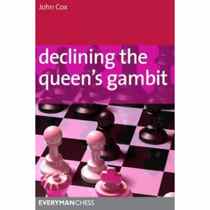Declining the Queen’s Gambit
John Cox

The popularity of this defense at the highest level was demonstrated this spring in Kazan. Time and again some of the best players in the world were unable to show even the smallest of advantages for White.
The present work is a repertoire book and as is typical for this genre Cox offers two choices for Black. Against the Queens Gambit proper this means the Tartakover (1.d4 d5 2.c4 e6 3.Nc3 Nf6 4.Bg5 Be7 5.Bg5 h6 6.Bh4 0-0 7.e3 b6) and the Lasker (6 0-0 7.e3 Ne4). These systems, both with excellent theoretical reputations, represent roughly a third of the book and 18 of the 53 heavily annotated games around which Declining the Queens Gambit is structured.
The Tartakover is open to more interpretation than the Lasker, principally in whether Black chooses setups based on …c5 or …c6. The former might objectively be a clearer route to equality but the resulting positions are often lifeless with little prospects of playing for a win. Anand-Carlsen, London Classic 2011, is a good example: 1.d4 d5 2.c4 e6 3.Nc3 Nf6 4.Bg5 Be7 5.Nf3 h6 6.Bh4 0-0 7.e3 b6 8.Be2 Bb7 9.Bxf6 Bxf6 10.cxd5 exd5 11.b4 c5 12.bxc5 bxc5 13.Rb1 Bc6 14.0-0 Nd7 15.Bb5 Qc7 16.Qc2 Rab8 17.Rfc1 Bxb5 18.Nxb5 Qc6 19.Nc3 cxd4 20.Nxd4 Bxd4 21.exd4 Rxb1 22.Nxb1 Qxc2 23.Rxc2 and nothing left to play for.
Cox, taking into account his readers will not be facing the World Champion, confines his coverage to Nigel Shorts favorite 11 c6 which does not permit such simplification. This is not the only line of Shorts that Cox recommends. After examining the Tartakover and Lasker as well as 6.Bxf6 and the currently trendy 4.Nf3 Be7 5.Bf4 0-0 6.e3 Nbd7, the author has a lengthy chapter on the Exchange Variation. This line has long been a favorite at both the amateur and professional level for its ability to steer play into familiar middlegames.
Once again it is Short that provides Cox with a way to sidestep large amounts of theory with his apparently “ugly 1.d4 d5 2.c4 e6 3.Nc3 Nf6 4.cxd5 exd5 5.Bg5 Bf5 6.e3 c6 7.Qf3 Bg6 8.Bxf6 Qxf6 9.Qxf6 exf6. Short (and Cox) show that despite initial impressions Black is actually doing fine here, his two bishops compensating for the damaged kingside pawns in this Berlin Wall equivalent of the QGD Exchange. This said there is one problem. After 6.Qb3 Nc6 the game is drawn: 7.Qxb7 Nb4 8.Rc1 Rb8 9.Qxa7 Ra8 and so forth.
Cox attempts to deal with this practical (not theoretical) difficulty by proposing a second system Lars Bo Hansens favorite 1.d4 d5 2.c4 e6 3.Nc3 Nf6 4.cxd5 exd5 5.Bg5 c6 6.Qc2 Be7 7.e3 Nbd7 8.Bd3 Nh5 and gives convincing demonstrations of its effectiveness. Unfortunately the old problem with move orders crops up if White avoids an early Qc2. For example, as Cox points out, 6.e3 Be7 7.Bd3 Nbd7 8.Nge2 and now 8… Nh5?! does not work out well after 9.Bxe7 Qxe7 10.g4! Nf6 11.Ng3 when White has achieved his maximal setup. Fortunately the two systems work well together and solve the problem: after 6.e3 Black can play 6 …Bf5 heading back into Shorts line having avoided the forced draw variation.
Cox completes his QGD repertoire by offering a line against the Catalan. In 1.d4 d5 2.c4 e6 3.Nf3 Nf6 4.g3 dxc4 5.Bg2 Bb4+ 6.Bd2 a5 he has chosen a very challenging and fashionable system employed by both Kramnik and Topalov. Coxs coverage is complete up to June of this year and while theory is constantly changing in this variation his explanation of what both sides are trying to achieve will still prove quite helpful even if a specific line is superseded in the future.
Declining the Queens Gambit is an excellent repertoire book that pairs up well the authors earlier Dealing with d4 Deviations (also Everyman Publishing), which covers everything after 1.d4 d5 except 2.c4. Throw in Coxs book on the Berlin Wall (Quality Chess) and you have a rock solid repertoire for Black that should hold up for a long time.
Recommended
